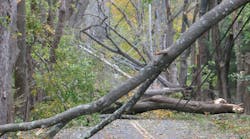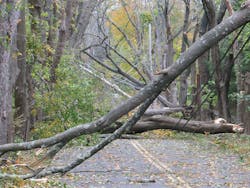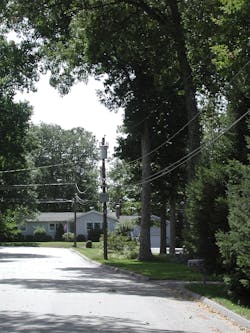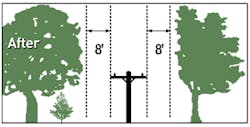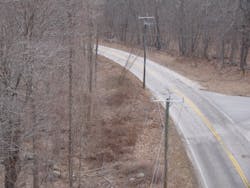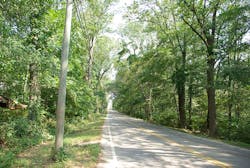Ahead of the Storm: CL&P’s Vegetation Management Plan
Wicked weather has pounded the Northeast repeatedly over the past two years. Numerous powerful storms have brought down countless trees and limbs, causing severe damage to Connecticut Light & Power’s (CL&P’s) electric system. The devastation knocked out power to hundreds of thousands of customers and made travel nearly impossible on roads choked with fallen trees.
After these storms, Connecticut residents had a much clearer picture of just how devastating the state’s beautiful scenery can be, and, with nearly 90% of storm outages caused by trees, CL&P seized the opportunity to launch an ambitious vegetation management program.
Located in one of the most heavily forested states in the U.S., CL&P had plenty of trees that could be trimmed, but the utility needed to be strategic in where to focus its resources. To prioritize the work, CL&P arborists and distribution system analysts reviewed the impact of recent storms on the utility’s 17,000 miles (27,359 km) of circuits and identified segments with historically poor performance. Of these segments, the major circuits, serving large blocks of customers, were given a high priority for enhanced trimming or tree removal.
Enhanced Tree Trimming
In 2012, CL&P conducted routine tree trimming along 3475 miles (5592 km), 1100 miles (1770 km) more than the year before. CL&P’s specifications for routine trimming are an 8-ft (2.4-m) clearance to the side of wires and poles, a 10-ft (3-m) clearance below wires and a 15-ft (4.6-m) clearance over wires. On certain main lines, some limbs above wires also were removed.
The enhanced tree trimming CL&P launched in 2012 is more extensive than this routine cycle maintenance trimming. It involves removing all overhanging branches and limbs within 8 ft of poles and wires from the ground up. Arborists also assess and remove high-risk trees that could fail and fall on the utility’s overhead infrastructure. Last year, CL&P performed this enhanced trimming on 662 miles (1065 km).
The State and Municipalities
Vegetation management has always been part of CL&P’s business plan. But, the extent of tree damage during recent storms prompted the state of Connecticut to take a closer look at statewide vegetation management practices. In April 2012, a state vegetation management task force was established. The task force included members from various utilities, municipalities, state agencies and conservation groups, and its goal was to develop standards for roadside tree care in Connecticut; vegetation management practices and schedules for utility rights-of-way; right-tree, right-place standards; standards for tree wardens; municipal tree inventories; and pruning schedules.
The task force found that, in most Connecticut towns, the utilities serve as de facto tree managers. Therefore, CL&P, serving 149 of Connecticut’s 169 municipalities, plays a critical role in the overall vegetation management in the state. As a member of this task force, CL&P’s vegetation management manager had the opportunity to work closely with many of the tree wardens for these municipalities and was even honored by the state’s association of tree wardens as an honorary tree warden last year.
CL&P’s budget for tree trimming is far greater than the municipal budgets, and, because of the amount of work it does in these towns, the utility’s relationship with the tree wardens has become essentially hand and glove. The utility is working closely with the tree wardens and other municipal officials in advance of tree trimming to discuss its strategy and provide an overview of where, when and why trimming will take place. A concerned resident will often call its local tree warden seeking information, and these relationships have become one of the utility’s keys to success.
Tree Trimming and Superstorm Sandy
Eight months after CL&P launched its enhanced tree-trimming program, Superstorm Sandy struck Connecticut, yet again bringing entire trees down on top of electrical wires and equipment. Thousands of downed trees and limbs cut off access to roads, inhibiting travel and making for challenging restoration work.
| National Rank | State | Percent of cover |
| 1 | New Hampshire | 88.9 |
| 2 | Maine | 83.1 |
| 3 | Vermont | 81.5 |
| 4 | West Virginia | 81.4 |
| 5 | Connecticut | 72.6 |
| 6 | Maryland | 70.8 |
Norwalk & Greenfield, Landscape and Urban Planning 107(2012)21-50
Implementing lessons learned from previous storms, CL&P assigned at least one of its tree contractor crews and line crews to work with each municipality affected by the storm. While line crews implemented the utility’s procedure to secure electrical hazards and ensure public safety, the tree crews provided critical assistance in opening roads. In total, more than 1600 tree workers assisted in CL&P’s response to Superstorm Sandy.
| Irene | Wind |
| Nor’easter | Heavy wet snow |
| Different events, different impact on trees |
Horizontal, dynamic loads Vertical, static loads |
While the cost of removing trees exceeded $30 million by the completion of the storm restoration, the damage could have been much worse had CL&P not begun its enhanced tree work earlier in the year. The utility found that in areas where enhanced tree trimming had been performed, the number of outages decreased by 50%, resulting in significant reliability improvements for CL&P customers.
Looking Ahead
In January 2013, Connecticut’s public utility regulatory authority approved CL&P’s system resiliency plan, a five-year plan designed to improve reliability and reduce the impact of severe weather.
The plan focuses on three major initiatives:
- Tree trimming
- Electrical hardening through the use of covered thicker-gauge conductor
- Structural hardening by strengthening utility poles, cross arms and related system equipment.
CL&P allotted 60% of the $300 million plan to vegetation management, meaning even more enhanced tree trimming and a transition from a five-year routine trimming cycle to a four-year cycle.
Throughout 2013, CL&P plans to conduct tree trimming work along 4,420 miles (7,113 km) of its distribution system, including 635 miles (1,022 km) of enhanced tree trimming on circuit backbone and lateral circuit segments serving large numbers of customers. The utility also will spend more money on mid-cycle hot-spot trimming on circuit backbones. This means the utility goes out two years after an area was trimmed and looks for cycle busters — trees that have grown into lines or limbs that have become damaged or dead, and pose a new threat to the system. When the utility identifies these threats, it removes them mid-cycle and does not wait for the next scheduled tree trimming.
Beyond tree trimming, the CL&P also will increase the number of at-risk trees it removes along circuit backbones. Trees are not the only vegetation the utility battles; it also will cut and treat vines along 5,000 miles (8,047 km) of line, including oriental bittersweet, poison ivy and grape, that grow up poles and guy wires.
Customer Focus
Trees, especially the fall foliage, are one of the things that make Connecticut a truly beautiful state. CL&P understands trees are important to its customers and works hard to balance the aesthetic goals of property owners with the utility’s reliability goals. The utility’s program is run by certified arborists and utility foresters, people who know and understand trees and who work diligently with customers to answer questions and address concerns.
The Connecticut legislature also recognizes the value residents place on their trees and has enacted unique legislation outlining the specific notification requirements for utility tree trimming. For all routine tree trimming, CL&P notifies property owners by mail of its plans to trim, and they have 15 days to respond with any concerns before work begins. Unlike routine trimming, the enhanced tree trimming requires written consent from the property owner before work begins. CL&P’s vegetation management team works closely with property owners, delivering forms and details about the tree work and answering questions so the utility can successfully obtain consent.
For many customers, CL&P is the go-to resource for tree information, and the vegetation management team responds to thousands of tree-related inquiries from customers. In 2012 alone, CL&P’s vegetation management team received 15,000 tree-related calls from customers; 85% of those calls were asking for a tree to be removed. When a customer asks for a tree to be removed, a team member goes to the location to investigate, and oftentimes finds the tree does not pose a direct threat to the electric system or threatens the telecommunications wires instead.
Customer education is a critical part of CL&P’s vegetation management. The utility works diligently to follow up on these customer requests and is involved in community education about proper tree maintenance. CL&P’s “Plan Before You Plant” guide instructs customers to select the right trees and shrubbery to grow near power lines.
In Connecticut, it is clear trees are the primary cause of power outages, and that is never more apparent than during severe weather. By trimming and removing trees through its vegetation management program that threaten the electrical system, CL&P is removing the hazards before Mother Nature has an opportunity to do so. It is all part of CL&P’s overall commitment to improving storm response and system reliability for its customers.
About the Author:
David Goodson is the manager of vegetation management at Northeast Utilities and is responsible for the distribution line clearance programs at the Connecticut Light & Power Co. and the Western Massachusetts Electric Co. Goodson has been active in tree care industry organizations throughout his career. He is a past president of the Connecticut Tree Protective Association and the New England Chapter of the International Society of Arboriculture. As a member of the ISA’s board of directors, he was chair of the finance committee. He was one of the founding members of the Connecticut Urban Forest Council and speaker at its Meskwaka Project. He is an honorary Connecticut Tree Warden and presently represents the Utility Arborist Association on the American National Standards Institute Z133.1 Tree Care Industry Safety Committee.
